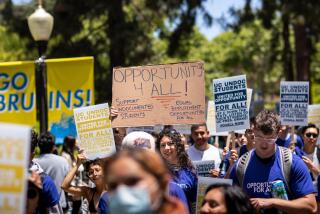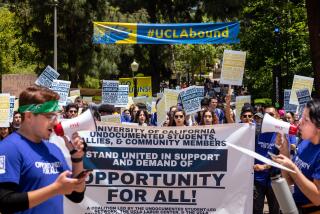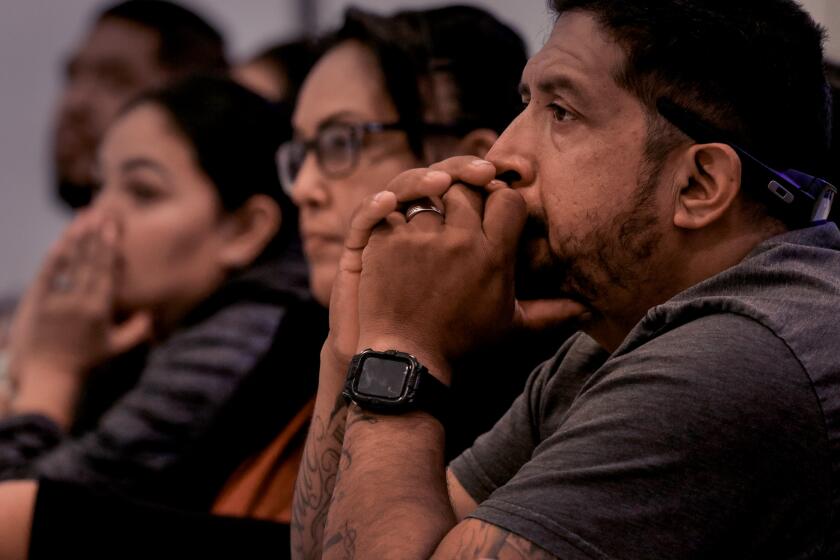Texas Case Looms Over Prop. 187’s Legal Future : Justice: U.S. high court voided that state’s ’75 law on illegal immigrants. But panel has since shifted to right.
TYLER, Tex. — Seventeen years ago, third-grader Laura Alvarez was kicked out of elementary school.
The Mexico City-born daughter of illegal immigrants, Laura was one of tens of thousands of youngsters to feel the consequences of a 1975 Texas law that--like California’s controversial Proposition 187--said undocumented children no longer qualified for a free public education.
A few days after being expelled, Laura recalls, she was awakened by her parents and seated in their aging station wagon for a pre-dawn ride on the clippity-clop, red-brick streets of downtown Tyler. Their destination: the imposing Federal Courthouse, where her parents, risking immediate deportation, testified in the courtroom of Judge William Wayne Justice.
The judge, acting on a lawsuit filed by civil rights lawyers, ordered Tyler schools Supt. James Plyler to allow undocumented students back into school. He also ordered that the identities of the 16 children named in the suit be withheld from the public to avoid possible harassment. The case, which came to be known as Plyler vs. Doe, eventually reached the U.S. Supreme Court, where, in a landmark 5-4 decision, the Texas law was declared unconstitutional.
As a result of that decision, Alvarez, now 26, was able to graduate from John Tyler High School in 1987. She now works as a teacher’s aide for the very school system that ejected her.
When California voters decide how to cast their ballots next month, the legal implications of Plyler vs. Doe will loom heavy over the ultimate fate of Proposition 187.
The California measure is far more sweeping than the Texas law. It would bar illegal immigrants from receiving non-emergency health and social services, as well as public education, and would require school and health officials to report suspected undocumented people to federal authorities. Many of its provisions are likely to inspire court challenges, but none more clearly than the educational component.
Sponsors of Proposition 187 readily acknowledge that the Supreme Court would have to revisit its 1982 decision in order for the education ban to take effect. A “yes” vote on Election Day, they say, will pave the way for the high court to take a second look at the matter.
Opponents of Proposition 187 counter that its passage will serve only to ensure taxpayers a time-consuming, divisive and ultimately unsuccessful legal battle. A vote for 187, they say, is an expensive exercise in futility.
In its ruling, the Supreme Court for the first time extended the constitutional guarantee of “equal protection of the law” to people living in the United States illegally.
It is unjust to penalize children for the illegal actions of their parents, the court’s majority said. And while public education is not a constitutionally granted right, it is nonetheless distinguishable from other forms of social welfare, the justices concluded, because of “the lasting impact of its deprivation on the life of the child.”
“By denying these children a basic education, we deny them the ability to live within the structure of our civic institutions, and foreclose any realistic possibility that they will contribute in even the smallest way to the progress of our nation.”
Sponsors of Proposition 187 say conditions in California are different from those in Texas in the mid-1970s. Such factors, they say, will give the Supreme Court reason to ignore or reverse its previous ruling.
For one thing, the magnitude of the illegal immigrant population appears greater in California. Here, the estimated number of youngsters who would be expelled exceeds 300,000--three to 30 times the number of undocumented young people that, according to various estimates, were attending school in Texas at the time.
By requiring school officials to report suspected illegal immigrant students and their parents to federal authorities, the initiative also takes a step, sponsors say, toward returning students to their native lands, where they could ostensibly complete their education.
Moreover, they emphasize, the makeup of the court has shifted dramatically to the right since the 1982 decision.
“Only one member who voted with the majority is still there,” noted Proposition 187 co-author Alan C. Nelson, a former commissioner of the U.S. Immigration and Naturalization Service.
Foes of Proposition 187 retort that the court has been extremely reluctant to overturn previous rulings, especially ones decided little more than a decade ago.
Besides, they say, the measure provides no clear provisions for deportation and is far more Draconian than the unconstitutional Texas law, which allowed children to remain in public school if they paid tuition fees.
Most important, opponents add, is that the net effect of the Texas law and the ballot measure are precisely the same: to create a policy that would scapegoat children for the sins of their parents and lead to the expulsion of thousands of undocumented students.
Leading constitutional law professors say the chances of the measure’s key educational sections being upheld are slim.
“This court is very serious about adhering to precedent in the absence of an overwhelming reason for change,” said Prof. Laurence Tribe of Harvard Law School.
However, some cautioned that the high court’s action is not a foregone conclusion.
“There’s always a possibility the court can simply draw on distinctions, and say it’s a different case in California, when anyone who looks at it says these distinctions don’t call for a different result,” said UCLA law professor Julian Eule.
Whatever the outcome, one thing is clear--the parameters of debate about illegal immigration have shifted markedly.
When the Supreme Court issued its ruling, even the judges who dissented wrote that expelling students is “senseless for an enlightened society.”
“It would be folly--and wrong--to tolerate creation of a segment of society made up of illiterate persons, many having a limited or no command of our language,” declared then-Chief Justice Warren E. Burger, in a minority opinion joined by William H. Rehnquist and Sandra Day O’Connor, both of whom remain on the court.
The California State Board of Education, made up of people appointed or reappointed by Pro-187 Gov. Pete Wilson, has declined to take a stand on the ballot measure. But back when the Supreme Court was considering the Plyler case, the California board filed a legal brief in favor of the Texas schoolchildren. “It has never been demonstrated that education is more expensive than ignorance,” the board wrote in 1981.
In recent times, Plyler has done some shifting himself. “If we don’t provide education, children will be a greater burden and cost more in the long run,” the retired Tyler school chief told The Times. “For taxpayers, it’s either pay me now, or pay me later.”
*
Tyler, a sleepy, sylvan East Texas city of 75,000, was home to roughly 40 undocumented youngsters back in the late 1970s.
When the state law first took effect, the city’s school district ignored it, picking up the cost of educating the children itself.
But that policy proved short-lived. In July, 1977, school board members, fearing that the city would turn into a haven for illegal immigrants, ordered them to pay $1,000 a year in tuition. The fee was tantamount to expulsion. Most of the immigrants had jobs in Tyler foundries or restaurants, but their pay was no more than $4,000 a year.
The 1977 school year began Aug. 31, and Rosario Robles still recalls the rebuff she received that morning when she walked her children to school.
Robles and her husband, Jose, a pipe factory employee, had lived together in Tyler for five years. Despite being undocumented, they owned their own home and paid school taxes.
Yet at Bonner Elementary, they were told: No birth certificates, no school. The principal proceeded to place Rosario Robles and five of her children in his car and drive them back home, she said.
The family made immediate arrangements for some of their children to temporarily attend a parochial school, with Jose Robles doing yardwork at the school in exchange for tuition. They also turned to a Catholic Church outreach worker, Michael McAndrew, who contacted local civil rights lawyer Larry Daves.
Daves, in turn, phoned the Mexican American Legal Defense and Educational Fund. Within two days, MALDEF attorney Peter D. Roos flew from San Francisco to Tyler. Working through the Labor Day weekend, Roos filed a lawsuit on behalf of four willing families.
Judge Justice scheduled a hearing for three days later and, to limit publicity, set it for 6 a.m.
That morning, Lidia Lopez and her husband, Jose, packed their Dodge Monaco with all their worldly possessions for the pre-dawn drive to the courthouse, Lidia Lopez recalls. If Justice denied their suit out of hand, she says, they were prepared to be arrested and deported immediately.
The four families entered the courthouse through a side door and participated in the hearing with the translation assistance of McAndrew.
Judge Justice informed the parents that he had no right to withhold their names from the U.S. Justice Department. But department officials decided not to take action against the families so the lawsuit could proceed.
Two days later, Justice granted an injunction and eventually declared that Tyler’s application of the law violated the equal protection provisions of the 14th Amendment to the U.S. Constitution.
However, the judge’s decision applied only to the Tyler school district. So a rash of similar lawsuits were filed across the state. When a decision was made to combine these suits, Los Angeles immigration rights attorney Peter A. Schey was called in as lead lawyer. That case was decided in the children’s favor by a federal district judge in Houston.
At the Supreme Court level, the two cases were combined into Plyler vs. Doe.
In its opinion, the high court ruled that illegal immigrants had the right to the same education as all other Texas children. In addition, the court noted, “there is no assurance that a child subject to deportation will ever be deported.”
“An illegal entrant might be granted federal permission to continue to reside in this country or even to become a citizen,” Justice William J. Brennan Jr. wrote in the court’s majority opinion.
Because of its focus on the importance of education, Plyler vs. Doe has never been extended to affect other types of benefits for illegal immigrants. It has nonetheless drawn its share of criticism.
In his dissent, Burger charged that the five majority justices were engaging in policy-making rather than accepting the will of the Texas Legislature, which said its law was meant to conserve budget funds for legal residents.
As long as the Legislature’s reasoning was rational, Burger wrote, high court justices had no jurisdiction to strike down the law, even if, as in this case, their motives were “noble and compassionate.”
Back in Tyler, Laura Alvarez was completing seventh grade. Immersed in school--and having been expelled for only a handful of days years earlier--she never even heard about the historic 1982 decision.
“As soon as I was back in school,” she explained last week, “I never thought anything more about it.”
*
As the years went by, the identities of the 16 Mexico-born children remained secret.
Among the curious was John C. Hardy, the Tyler attorney who represented the school district before the Supreme Court. “I just wonder if they made it through school--who graduated and what they did with the opportunity that was given to them.”
With names provided by Daves, The Times this month was able to track down three of the four families and compile information on 13 of the 16 youngsters in the case.
As it turns out, 10 finished high school in Tyler. Many have gone on to take college courses, although none has graduated from a four-year institution. Several are single and others are married with as many as four children. Most have full-time jobs--two work as teacher’s aides, two on a box factory assembly line, and others as auto mechanic, burger stand manager, painter and stock clerk. Three are full-time housewives.
Family members say all are now legal residents, mainly through the federal amnesty program of the mid-1980s. In short, the “Does” of Plyler vs. Doe turned out a little like many other blue-collar schoolchildren across small-town America.
“Without an education, I don’t know where I’d be right now,” reflects Alvarez, who, before being contacted by The Times, had never publicly revealed her participation in the lawsuit. “I’m a taxpayer now and you have to view everything from both sides, but if a child is denied an education, they’re going to be a burden.”
Alfredo Lopez, a 1987 graduate of Tyler High, said, “The only reason I got in the automotive business is because I took automobile mechanic courses in high school which led to my employment.”
Lopez actually has two jobs--as a Sears auto mechanic and a warehouse worker. He also has a Tyler-born wife of Mexican descent, two young children and a house with a 15-year mortgage.
“Alfredo is a fine young man,” said Jim Blake, his boss at Sears. “He’s very honest, an upstanding young man in the community.”
Blake shudders to think what would have happened to Lopez and the others if they had been tossed out of public school before they were 10 years old. “We have to do something to control our border,” he said, “but I can’t see throwing kids on the street.”
Only one of the four “Doe” families has moved out of Tyler, and, according to McAndrew, the children probably fared more poorly. “Their mother was separated from the father and had humongous problems with welfare,” McAndrew, now an immigration counselor, said. “If she worked, the kids would be taken away from her. If she didn’t, there was not enough money. The children were very small at the time, and they had a stacked deck against them.”
*
With the election 16 days away, Proposition 187 has become the hottest issue in California, and the education ban is at the heart of the matter.
“We’re quite aware of Plyler and that needs to be dealt with,” said former INS chief Nelson. “I welcome the chance to bring these matters before the courts.”
To be precise, the lawsuit would be handled at taxpayers’ expense through the state attorney general’s office. Staffers have already spent time studying the matter to prepare for an immediate blitz of lawsuits if Proposition 187, which currently holds a solid lead in statewide polls, wins approval.
Among those planning suits are Roos and Schey, the two key attorneys for the schoolchildren in Plyler vs. Doe.
If the initiative passes, Schey said, “the only result is that taxpayers will foot the bill for years of litigation and the chances of it ever being implemented are close to zero.”
*
In recent years, Tyler has witnessed some of the same signs of progress and growing pains as many other American towns.
Strip malls now gather like tumbleweed on the Southeast Loop Road. Street gangs and drive-by shootings have also come to Tyler. Last Monday, a 17-year-old alleged gang member was found shot to death in the city’s oldest park. It was the third gang-related killing reported in Tyler this year.
Next year, Alfredo Lopez’s young son, Michael, is due to start kindergarten. Lopez says he is working two jobs to help scrape together the money to allow Michael to attend private school.
“The public schools have changed drastically--there are too many students per teacher and now we have metal detectors in our schools,” Alfredo said. “We didn’t have anything like that when I graduated.”
Still, there is no talk here of revisiting the Plyler decision.
“It was a landmark case,” said school board attorney Hardy, “and one of the obstacles California would face is the fact that by historical standards, it happened yesterday.”
Over at the courthouse, Judge Justice, now nearly 75 years old, is still going strong. But Plyler vs. Doe is the last thing on his mind.
“It may seem like a hot new issue in California,” explained Justice’s secretary, Evelyn Armstrong. “But here in Tyler, it’s in the past.”
1 ‘Aye,’ 2 ‘Nays’ Still on Court
In its June 15, 1982, Plyler vs. Doe ruling, the U.S. Supreme Court struck down as unconstitutional a 1975 Texas law that cut off state funds for the schooling of illegal immigrants.
The five justices in the majority were William J. Brennan Jr., Thurgood Marshall, Harry A. Blackmun, John Paul Stevens and Lewis F. Powell Jr. Only Stevens remains on the court.
The four dissenting judges were Chief Justice Warren E. Burger, William H. Rehnquist, Sandra Day O’Connor and Byron R. White. Rehnquist, now the chief justice, and O’Connor remain on the court.
More to Read
Sign up for Essential California
The most important California stories and recommendations in your inbox every morning.
You may occasionally receive promotional content from the Los Angeles Times.










